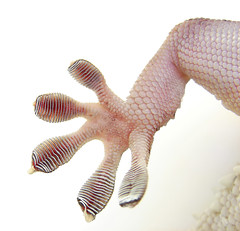
- Image by Furryscaly via Flickr
A Stanford mechanical engineer is using the biology of a gecko’s sticky foot to create a robot that climbs.
In the same way the small reptile can scale a wall of slick glass, the Stickybot can climb smooth surfaces with feet modeled on the intricate design of gecko toes.
Mark Cutkosky, the lead designer of the Stickybot, a professor of mechanical engineering and co-director of the Center for Design Research, has been collaborating with scientists around the nation for the last five years to build climbing robots.
After designing a robot that could conquer rough vertical surfaces such as brick walls and concrete, Cutkosky moved on to smooth surfaces such as glass and metal. He turned to the gecko for ideas.
“Unless you use suction cups, which are kind of slow and inefficient, the other solution out there is to use dry adhesion, which is the technique the gecko uses,” Cutkosky said.
Wonders of the gecko toe
The toe of a gecko’s foot contains hundreds of flap-like ridges called lamellae. On each ridge are millions of hairs called setae, which are 10 times thinner than a human’s. Under a microscope, you can see that each hair divides into smaller strands called spatulae, making it look like a bundle of split ends. These split ends are so tiny (a few hundred nanometers) that they interact with the molecules of the climbing surface.
The interaction between the molecules of gecko toe hair and the wall is a molecular attraction called van der Waals force. A gecko can hang and support its whole weight on one toe by placing it on the glass and then pulling it back. It only sticks when you pull in one direction — their toes are a kind of one-way adhesive, Cutkosky said.
“It’s very different from Scotch tape or duct tape, where, if you press it on, you then have to peel it off. You can lightly brush a directional adhesive against the surface and then pull in a certain direction, and it sticks itself. But if you pull in a different direction, it comes right off without any effort,” he said.








